In Greece, classical civilization threads all aspects of daily life. Broken Ionic columns lie in everyone’s backyard, and the bus maps are written in the language of the philosophers. But Crete, the largest island in 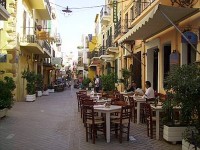 Greece, has more than just a Platonic heritage. Crete was once the heart of the Minoan civilization, a Bronze Age matriarchy that ruled the Mediterranean. Later conquests by the Byzantines, Turks and Venetians diversified the culture. With beaches, fierce local pride, cafes packed with soccer fans, goat farmers, university towns, and a wild mountainous terrain, Crete has something to offer travelers of many styles.
Greece, has more than just a Platonic heritage. Crete was once the heart of the Minoan civilization, a Bronze Age matriarchy that ruled the Mediterranean. Later conquests by the Byzantines, Turks and Venetians diversified the culture. With beaches, fierce local pride, cafes packed with soccer fans, goat farmers, university towns, and a wild mountainous terrain, Crete has something to offer travelers of many styles.
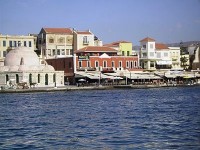 Charming Hania (sometimes spelled Chania) feels like a quintessential European city. Originally an ancient Minoan settlement, Hania later became a port for the Venetian Empire. The Venetians clearly felt homesick, because they filled the central town with pastel-colored stucco buildings and winding, cobbled alleyways reminiscent of Italy.
Charming Hania (sometimes spelled Chania) feels like a quintessential European city. Originally an ancient Minoan settlement, Hania later became a port for the Venetian Empire. The Venetians clearly felt homesick, because they filled the central town with pastel-colored stucco buildings and winding, cobbled alleyways reminiscent of Italy.
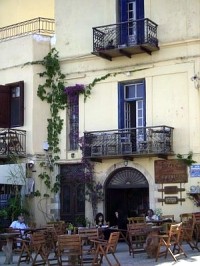 Most guests stay in one of Hania’s boutique hotels. We, however, found Pension Lena, which consisted of only a few rooms tucked into a restored Turkish building. Buoyant and full of information, Lena gave us a basket of fresh plums from her garden and sat us down for the rundown of Crete. She had decorated the pension with a mix of antiques, creating an eclectic but elegant atmosphere. We had coffee on a rooftop patio with a sliver of a view; the blue Mediterranean sparkling in the distance. It was tempting enough to make us chug our coffee and start exploring.
Most guests stay in one of Hania’s boutique hotels. We, however, found Pension Lena, which consisted of only a few rooms tucked into a restored Turkish building. Buoyant and full of information, Lena gave us a basket of fresh plums from her garden and sat us down for the rundown of Crete. She had decorated the pension with a mix of antiques, creating an eclectic but elegant atmosphere. We had coffee on a rooftop patio with a sliver of a view; the blue Mediterranean sparkling in the distance. It was tempting enough to make us chug our coffee and start exploring.
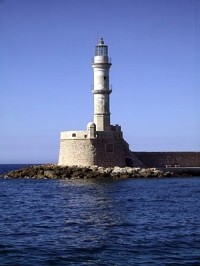 Hania’s rich history is evident in its architecture. A distinctive Venetian lighthouse sits upon a jetty overlooking the sea while guarding the city. The remains of a large mosque, now an art gallery, stands on the western side of the harbor. Along the Venetian fortress walls is the Naval Museum which provides a seafaring perspective to the island’s history. And inside the Old Town, the Hania Archeological Museum showcases artifacts from the town’s ancient past.
Hania’s rich history is evident in its architecture. A distinctive Venetian lighthouse sits upon a jetty overlooking the sea while guarding the city. The remains of a large mosque, now an art gallery, stands on the western side of the harbor. Along the Venetian fortress walls is the Naval Museum which provides a seafaring perspective to the island’s history. And inside the Old Town, the Hania Archeological Museum showcases artifacts from the town’s ancient past.
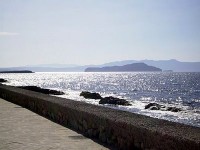 Lena’s is only a fifteen-minute walk from Nea Hora, Hania’s popular sandy beach. There we watched fishermen string lines of octopus to dry in the sun – a grisly, if distinctive, sight. Greek kids splashed in the shallow water while their parents added another layer of bronze to their already copper tans. This more modern sector of Hania can be overrun with package tourists, and other than the beach, it offers little for independent travelers.
Lena’s is only a fifteen-minute walk from Nea Hora, Hania’s popular sandy beach. There we watched fishermen string lines of octopus to dry in the sun – a grisly, if distinctive, sight. Greek kids splashed in the shallow water while their parents added another layer of bronze to their already copper tans. This more modern sector of Hania can be overrun with package tourists, and other than the beach, it offers little for independent travelers.
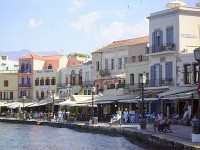 Serious beach bums will want to explore Crete’s less urban coast. Hania is a popular departure point for Elafonisi, a pristine islet off the southwest coast of Crete. Buses from Hania arrive daily, dropping loads of daytrippers onto a breathtaking stretch of white sand. Many visitors wade out 100 yards across the clear, shallow water to reach the islet, and then take the bus back to Hania in time for dinner.
Serious beach bums will want to explore Crete’s less urban coast. Hania is a popular departure point for Elafonisi, a pristine islet off the southwest coast of Crete. Buses from Hania arrive daily, dropping loads of daytrippers onto a breathtaking stretch of white sand. Many visitors wade out 100 yards across the clear, shallow water to reach the islet, and then take the bus back to Hania in time for dinner.
We found shopping in Hania to be expensive but high-quality. Artisans sell leather goods, jewelry, and local jams and honeys – a nice change from plaster moulds of the Parthenon and Zeus key chains. We often couldn’t find our way back through the maze of alleys once we had passed a shop, so we made it a point to buy on a whim.
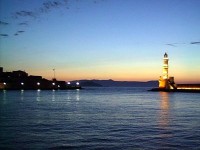 At dusk, we joined the crowds for a leisurely stroll of the waterfront. It seemed the entire population of the city turned out to walk. The harbor restaurants tended to be overpriced, so we had dinner in the Old Town. Housed in an old Turkish bathhouse, Tamam combined traditional Cretan and Turkish food. We had eggplant moussaka, salty white cheese with bread, and a meze platter of assorted appetizers. The mix of cuisines made the meal especially interesting – another testament to Crete’s unique past.
At dusk, we joined the crowds for a leisurely stroll of the waterfront. It seemed the entire population of the city turned out to walk. The harbor restaurants tended to be overpriced, so we had dinner in the Old Town. Housed in an old Turkish bathhouse, Tamam combined traditional Cretan and Turkish food. We had eggplant moussaka, salty white cheese with bread, and a meze platter of assorted appetizers. The mix of cuisines made the meal especially interesting – another testament to Crete’s unique past.


Comments